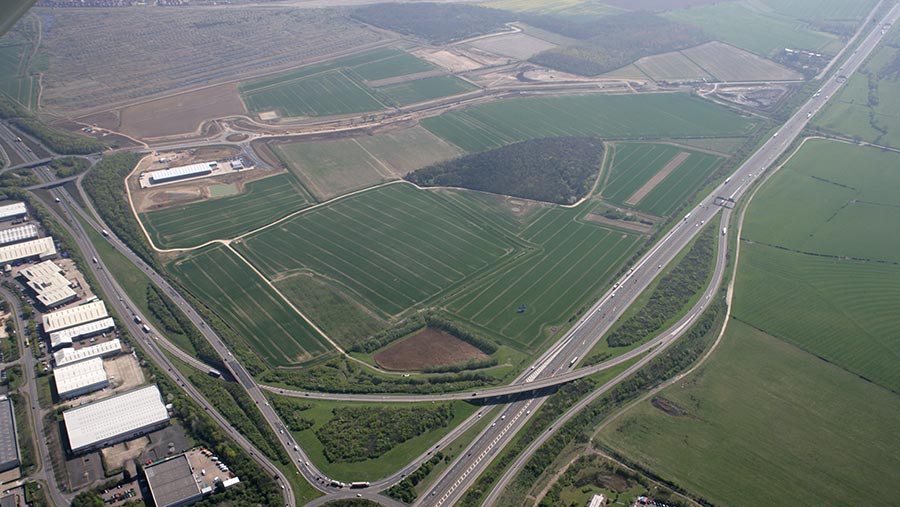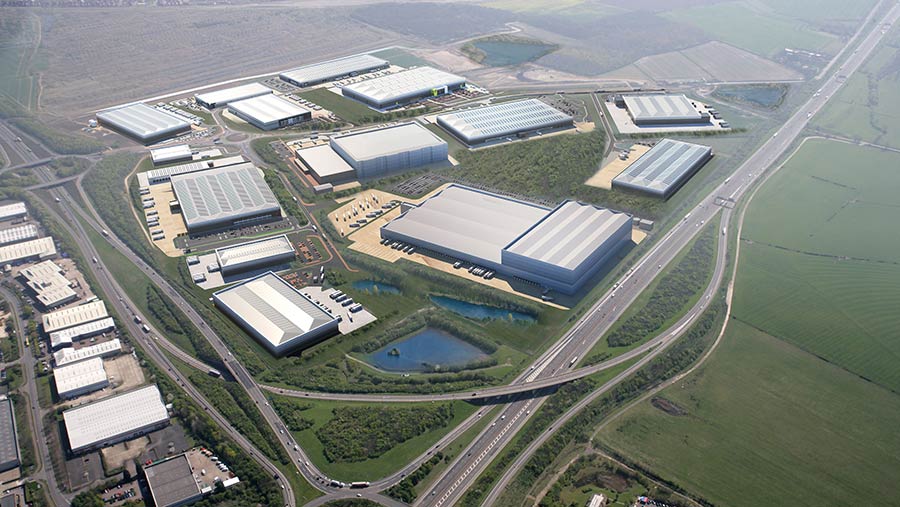Move to online ordering drives demand for development land
Land for distribution and logistics buildings is a market described as ‘on fire’, with the pandemic having shifted online ordering into a new gear. Suzie Horne asked Patrick Stanton of Bidwells about this type of development
What is the background to this market?
“The market was already seeing positive evolution through 2016 into early 2020, as growth in online sales drove demand from retailers, supermarkets, parcel carriers and other third-party logistics operators.
“In March 2020 the Covid-19 pandemic gave the warehouse and logistics market its own booster shot. It has taken the market to extraordinary heights, with close to 50m sq ft of deals in 2020. The likes of Amazon, DHL, Boohoo.com and Wayfair all acquired additional space during the last 12 months.
“Amazon alone is said to have accounted for close to 20% of all take-up last year. Warehouses are also getting bigger – 500,000 sq ft (the equivalent of 10 football pitches, or almost 12 acres) used to be considered a large unit for the sector.
“Several national operators are looking for buildings of between 500,000 and 1m sq ft and because of lack of supply they are all having to consider built-to-suit options on what is effectively agricultural land.
See also: Planning permission advice
“Buildings of this size are becoming more common as occupiers look to consolidate existing second-hand buildings into larger, fit-for-purpose, distribution centres.
“Demand is national, but currently there is significant demand in an area including Oxford, Milton Keynes, Cambridge, Peterborough, East Anglia and London.

© Bidwells
The Peterborough Gateway development is on 240 acres of agricultural land at Junction 13 of the A1(M). It is a joint venture agreement between a local landowner and Newlands Developments. Outline planning consent was secured by the developer in 2012 for warehouse and industrial use, with 4.1m sq ft of buildings now completed and with a gross value of more than £300m. Occupiers include DPD (distribution), Amazon, Lidl and Urban Outfitters.

© Bidwells
What is this doing to the land market and values?
“The value of ‘Big Box’ logistics and industrial sector land is, in some areas, catching up fast with residential values and, if managed correctly, can present significant opportunities for landowners.
“With land values of £400,000 to £2m an acre for such developments (with planning permission for industrial use and depending on location) we would encourage landowners to not always think residential.
“There may be advantages for some landowners looking to sell for development in having an industrial rather than a residential development on their doorstep.
“The increase in building size and demand is putting severe pressure on land supply. Sites capable of delivering large-scale warehouse space will be developed out much quicker than historical trends suggest.
“A site which has planning consent for, say, 2m sq ft of warehouse space would historically take perhaps five to 10 years to develop out in possibly 10 to 15 separate transactions with different potential occupiers.
“Today a 2m sq ft site may only need to attract three or four occupiers before the site is fully developed, so things are moving much faster.
What type of land is suitable?
“Ideally it’s better if it is grade 3 or poorer, but if it’s a good site, there is no restriction on the land grade.”
What are the essential elements of a suitable site?
Road links are critical – sites need to be close to motorways and major A-roads – close to a junction is ideal. Hauling goods and product is expensive and such sites enable ease of access to ports, cities and customers
Close to employment hubs – tight labour supply means employment has become expensive
Good infrastructure – power, water and ideally gas connections. Power is becoming a real issue with occupiers demanding more. Many are looking for vehicle charging points and production facilities are becoming more power hungry. Amazon aims to have all its vans electric by 2025
Away from residential areas – while policy dictates building must adhere to noise and nuisance rules it would still be wise to be away from residential areas unless for smaller urban logistics-type developments with smaller buildings.
How can a landowner assess the development opportunity?
“If a site ticks the boxes on the essential elements [see panel above] speak to both a planning expert and an agent. It is no good a planner saying you could build a 500,000 sq ft warehouse unit if ultimately the agent says demand is more likely to be for 20,000-100,000 sq ft buildings in that particular location.
“Check the local plan for likely inclusion or exclusion of a site. Generally speaking, councils are not proactive about identifying new employment opportunities.
“They rely heavily on promoters and developers to put forward farmland which they believe would make suitable sites for warehouse and logistics development.
“Councils, planners and policymakers must begin to appreciate the size and scale of this sector in its present form, but also understand that all forecasts point to continued and substantial growth, which will require many more acres of agricultural land to be allocated for this critical use.
“Projects will be lost to another area if they fail to recognise the demand and growth rates.
“There’s a lot in it for local authorities in terms of business rates and planning fees. For example, a 500,000 sq ft industrial development might yield £1m to £1.5m a year in business rates.
“There are specialist land promoters for the logistics and industrial sector. They know which buttons to push and, in some cases, can fast-track planning on sites where they already have engagement with potential occupiers to support job creation and economic growth in the planning process.
“However, the process to qualify a site to be included within a local plan can be costly, with no certainty that planning will then be forthcoming.”
How are land deals secured?
“Option agreements are the most straightforward for landowners, as usually all the risk and cost is with the developer.
“The developer will make an upfront payment in return for the ability to buy the land at a set price in future, usually within five to 10 years. The developer will agree to apply for planning permission at their own cost during the period of the option and if permission is granted and is satisfactory to the developer, then they may exercise their option to buy the land.
“Every site is different, but a typical option payment on a 300-acre site might be £150,000.
“However, landowners need to understand that, even having paid the option cash upfront, the developer is under no obligation to take that site forward, and until the option is either exercised or lapses, that land cannot be developed in any other way.
“Promotion agreements are another route – this way a land promoter undertakes to get planning permission within a set timescale, at no cost risk to the landowner. Once planning has been secured, the promoter markets the land, with the promoter taking an agreed proportion of the sale proceeds and being reimbursed for all their costs.
“If planning is not achieved within the agreed timescale, the promotion agreement lapses and the landowner does not have to pay the promoter’s costs.
“The main difference is that landowners usually have more input and control with a promotion agreement, because effectively they are sharing some risk. In an option scenario, the landowner can sit back and let the developer carry the risk and cost.
“Each site is different. Some might be more straightforward in terms of planning and therefore the landowner may wish to take more risk for higher reward. However, other sites may present a much higher planning risk and therefore taking an initial capital payment for zero risk might be the preferred option.
“A joint venture between a landowner and a developer may also be possible – these are very bespoke and less common than the other two routes.”
UK online sales growth
Online sales accounted for just 2.8% of retail sales in November 2006 and grew steadily, reaching 19.1% in February 2020. They then accelerated rapidly to a peak of 36.3% of all retail sales in both November 2020 and January 2021, driven by the pandemic. They have since fallen to 27.3% (May 2021).
Source: ONS
Patrick Stanton is a partner in Bidwells and heads the firm’s industrial and logistics team.
